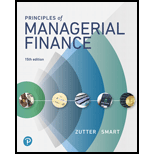
Concept explainers
N and M Corp, is considering leasing a new machine for $25,000 per year. The lease arrangement calls for a 5-year lease with an option to purchase the machine at the end of the lease for $3,500. The firm is in the 34% tax bracket. What is the
To determine:
Present value of lease cash flows.
Introduction:
The Present Value is the present sum of future money at a discounted rate of interest.
Explanation of Solution
The N and M corp. is considering leasing a new machine and the value of lease is $25,000 per year for the period of 5 years. At the end of 5 years, the corp. can purchase the machine at a price of $3,600. It is also given that the firm comes under the tax bracket of 34 percent.
The after tax cost of debt is 7 percent and thus the after tax cash outflow from the lease can be calculated by the following formula:
Thus, the after tax cash outflow from the lease is $16,500.
Present Value of the lease payments can be calculated by the use of the discounting method as follows:
Here, the number of years N is 5 years, Interest rate is 7 percent and the PMT is -$16,500. Thus, the PV can be calculated as follows:
The present value of the lease payments at the end of the year is $67,653.26.
The present value of the end-of-lease purchase can be calculated as follows:
The present value of the end-of-lease purchase is $2,495.45.
Thus, the present value of all cash outflows can be calculated by summating the two as follows:
Thus, the present value of all cash outflows is $70,148.71.
Want to see more full solutions like this?
Chapter 17 Solutions
Gitman: Principl Manageri Finance_15 (15th Edition) (What's New in Finance)
Additional Business Textbook Solutions
Financial Accounting (12th Edition) (What's New in Accounting)
Macroeconomics
Foundations Of Finance
Principles Of Taxation For Business And Investment Planning 2020 Edition
Principles of Operations Management: Sustainability and Supply Chain Management (10th Edition)
Corporate Finance (4th Edition) (Pearson Series in Finance) - Standalone book
 EBK CONTEMPORARY FINANCIAL MANAGEMENTFinanceISBN:9781337514835Author:MOYERPublisher:CENGAGE LEARNING - CONSIGNMENT
EBK CONTEMPORARY FINANCIAL MANAGEMENTFinanceISBN:9781337514835Author:MOYERPublisher:CENGAGE LEARNING - CONSIGNMENT
 Intermediate Financial Management (MindTap Course...FinanceISBN:9781337395083Author:Eugene F. Brigham, Phillip R. DavesPublisher:Cengage Learning
Intermediate Financial Management (MindTap Course...FinanceISBN:9781337395083Author:Eugene F. Brigham, Phillip R. DavesPublisher:Cengage Learning


